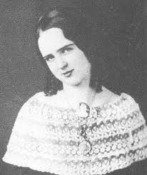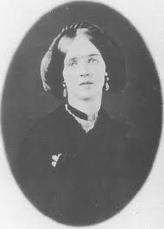 South Carolina Beauty, Lucy Pickens, was not only the perfect example of the classic Southern Belle, but is renowned as the only woman to have her gorgeous image appear on several different denominations of Confederate currency and lends to the inference of Lucy’s moniker as the Confederate Queen. Lucy became highly acclaimed throughout the South for her “classic features, titian hair, pansy eyes, and graceful figure.” In 1850, after a visit with the family of Mississippi governor John Quitman, Lucy looked in on the legislature, which then adjourned in her honor. By selling the jewels that had been given her in Russia, Lucy helped outfit the South Carolina Confederate Army unit that bore her name, the Lucy Holcombe Legion. Lucy thrived in the social world of the Belle. She loved the attention she received from her many male suitors and clearly had a sense of the dramatic. At the same time, she did not want to appear to be indecorous or to challenge the rules that governed life for women in her patriarchal society.
South Carolina Beauty, Lucy Pickens, was not only the perfect example of the classic Southern Belle, but is renowned as the only woman to have her gorgeous image appear on several different denominations of Confederate currency and lends to the inference of Lucy’s moniker as the Confederate Queen. Lucy became highly acclaimed throughout the South for her “classic features, titian hair, pansy eyes, and graceful figure.” In 1850, after a visit with the family of Mississippi governor John Quitman, Lucy looked in on the legislature, which then adjourned in her honor. By selling the jewels that had been given her in Russia, Lucy helped outfit the South Carolina Confederate Army unit that bore her name, the Lucy Holcombe Legion. Lucy thrived in the social world of the Belle. She loved the attention she received from her many male suitors and clearly had a sense of the dramatic. At the same time, she did not want to appear to be indecorous or to challenge the rules that governed life for women in her patriarchal society.
 Lucy Petway Holcombe, the second of five children of Beverly LaFayette and Eugenia Dorothea (Hunt) Holcombe, was born on June 11, 1832, near La Grange, Fayette County, Tennessee, on the Holcombe plantation, named Westover of Woodstock. She attended La Grange Female Academy and in 1846, with her older sister, Anna Eliza, began study in Bethlehem, Pennsylvania, at the Moravian Seminary for Young Ladies, which she attended for two years. Between 1848 and 1850 the Holcombes moved to Marshall, Texas. While awaiting completion of the mansion on their nearby plantation, Wyalucing, the family resided in a Marshall hotel. The Presbyterian church of Marshall was organized in the Holcombes’ rented quarters and Lucy’s father, Beverly Holcombe, became its first elder. While in Texas, Lucy, using the pseudonym H. M. Hardeman, wrote The Free Flag of Cuba, or the Martyrdom of Lopez: A Tale of the Liberating Expedition of 1851, a novelette published in 1855 by the New York publishers DeWitt and Davenport.
Lucy Petway Holcombe, the second of five children of Beverly LaFayette and Eugenia Dorothea (Hunt) Holcombe, was born on June 11, 1832, near La Grange, Fayette County, Tennessee, on the Holcombe plantation, named Westover of Woodstock. She attended La Grange Female Academy and in 1846, with her older sister, Anna Eliza, began study in Bethlehem, Pennsylvania, at the Moravian Seminary for Young Ladies, which she attended for two years. Between 1848 and 1850 the Holcombes moved to Marshall, Texas. While awaiting completion of the mansion on their nearby plantation, Wyalucing, the family resided in a Marshall hotel. The Presbyterian church of Marshall was organized in the Holcombes’ rented quarters and Lucy’s father, Beverly Holcombe, became its first elder. While in Texas, Lucy, using the pseudonym H. M. Hardeman, wrote The Free Flag of Cuba, or the Martyrdom of Lopez: A Tale of the Liberating Expedition of 1851, a novelette published in 1855 by the New York publishers DeWitt and Davenport.
While on vacation with her family at White Sulphur Springs, Virginia in 1856, Lucy met Francis Wilkinson Pickens, of South Carolina, twice a widower and twenty-seven years her senior. Her acceptance of his marriage proposal, it is said, hinged on his acceptance of a diplomatic post abroad. President James Buchanan appointed him ambassador to Russia, and on April 26, 1858, at Holcombe Pantation, Wyalucing, Pickens and Lucy were wed.
Spending Picken’s money freely, Lucy dazzled the royals. With her knowledge of
French and Russian and her elaborate wardrobe, she was soon a favorite of the
court in St. Petersburg. Czar Alexander II and Czarina Maria showered the couple
with gifts of jewels and other treasures. The Picken’s child, Eugenia Frances Dorothea was born in 1859 in the royal palace and the Czar and Czarina became her godparents. She was christened Olga Neva and was called “Douschka” meaning “little darling”. At the baptism of the child the Czar and Czarina stood as godfather and godmother, and the Czar gave her the name of Olga Neva Francesca Eugenia Dorothea Pickens.
Foreseeing troubled times for the South, Pickens resigned his diplomatic post in Russia and in the fall of 1860 returned home. He was elected governor by the South Carolina legislature and was inaugurated on December 17, 1860, four days later South Carolina left the Union.
 Pickens ordered the Morris Island battery to fire on the USS Star of the West as the ship delivered supplies to Union forces at Fort Sumter in Charleston harbor, the first military engagement of the Civil War. Lucy became the center of attention in South Carolina, giving grand parties. In a show of patriotism to the Southern cause, she sold some of the jewelry she had received from the Russian royal family to buy uniforms for South Carolina soldiers.
Pickens ordered the Morris Island battery to fire on the USS Star of the West as the ship delivered supplies to Union forces at Fort Sumter in Charleston harbor, the first military engagement of the Civil War. Lucy became the center of attention in South Carolina, giving grand parties. In a show of patriotism to the Southern cause, she sold some of the jewelry she had received from the Russian royal family to buy uniforms for South Carolina soldiers.
Grateful for the gesture, the commander of the Citadel raised a force of infantry, artillery, and cavalry, and named it the Holcombe Legion. Its flag was a blue banner with the South Carolina white palmetto tree on it and a star of Texas, Lucy’ home.
She became known as Lady Lucy, and her likeness appeared on Confederate
currency – the $1 bill of 1862 and the $100 bills of 1863 and 1864. She was the only
woman to appear on Confederate currency. Journalists called her the Queen of
the Confederacy.
She is also credited with playing a role in the Confederate government as an advisor and confidante to her husband. Although the war wreaked havoc on the South and poverty abounded, Lucy managed to keep the Picken’s home, Edgewood, at the center of social circles.
In January 1869, Francis Pickens died at Edgewood. Lucy continued to live there
and managed three plantations with the help of her brother John. Though only 36
when her husband died, Lucy never remarried.
She managed their cotton plantation in Edgefield County, South Carolina, and provided financial assistance to family members, in part through additional sales of the jewelry she had acquired in Europe. She lamented the end of slavery and devoted herself to the Lost Cause, serving as president of the county’s ladies memorial association and spearheading the effort to erect a monument on Edgefield’s courthouse square.
She died at her home, Edgewood, on August 8, 1899, of a cerebral embolism, and was buried near her husband and daughter in Edgefield Cemetery.
South Carolina Beauty, Lucy Pickens, was often referred to as the Queen of the Confederacy. She had developed, at an early age, the ability to follow the money, in order to further her social ambitions, goals and pursuits. Actually, most find only loneliness and tragedy in this pursuit, however the Confederate Queen, somehow managed to weather the financial catastrophe experienced by other southern families after the Civil War.
Bummer


Great Southern story…..Classic…..
Good to see you back.
Patrick
Had some issues that required much personal time. I much respect your perseverance and fortitude. Have continued following your thoughts and scholarship. Look forward more to telling the tales than fighting the politics. Enjoy your views.
Bummer